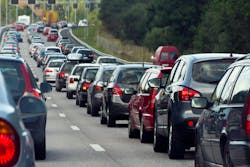From Gridlock to Go
Key Takeaways
- Cities are turning to AI, IoT, and other smart mobility applications to reduce congestion, improve safety, and modernize outdated tolling systems.
- Digital tolling and API-based “pay-as-you-go” models create fair, flexible options for drivers while improving efficiency and revenue collection.
- Declining gas tax revenue is driving interest in digital funding models like road usage charging and public-private partnerships to support future infrastructure.
Navigating cities can often feel like a struggle against gridlock, congestion and inefficiency. New digital solutions and technology in urban mobility, however, offer a way forward, with practical tools that can make your daily commutes and weekend road trips smoother, fairer and safer.
North America is on the cusp of a revolution that can redefine urban mobility, but we need to evolve from the outdated information technology infrastructure that holds back change.
Aging transportation systems reliant on manual processes and legacy hardware technology are failing to keep pace with rapid urban growth and the changing needs and expectations of today’s drivers.
The INRIX 2024 Global Traffic Scorecard showed that congestion costs an average of 43 hours per driver annually, or 4 billion total hours lost, costing $74 billion in lost time.
Congestion is driven by the rapid growth of urban areas across the country. For example, the U.S. Census Bureau estimates Texas added more than 470,000 residents between 2022-2023 in cities such as Austin and Dallas, and the suburban areas around them drives demand for new infrastructure. Similarly, Oregon’s population jumped from 2019-2023, particularly in Portland’s metro are. This city faces increased traffic pressure, according to transportation and demographic reports.
Urban growth strains mobility infrastructure, opening the door for tolling projects. However, legacy tolling systems that rely on transponders and tags are trusting technology that’s more than 30 years old.
Digital tools are essential to driving meaningful change, but cities continue to lean on 20th century solutions.
Cities can use smart applications, artificial intelligence (AI) and Internet of Things (IoT) to optimize toll payments, improve toll collections, improve traffic flow and add safety measures. But it requires bold adoption.
Real-time road condition alerts highlight the potential for digital solutions to improve safety and traffic management.
Pittsburgh cut traffic congestion by 26% and emissions by 21% using AI to control traffic signals in real-time, according to a Carnegie Mellon University initiative.
Similarly, experimental in-vehicle speed limit alerts using connected vehicle-to-everything (CV2X) technology can deliver real-time warnings about road conditions and closures to drivers via apps, which are superior to GPS systems that rely on post-incident reports.
Cities adopting application program interface (API)-based tolling technology benefit operators and drivers, allowing each to embrace flexible “pay-as-you-go” models, similar to Uber or DoorDash. This reflects a growing demand for technology that fits modern lifestyles, with millions of transactions processed as evidence of its potential impact.
Cities that embrace innovative technology and leverage real-time data can leave gridlock – and unpaid toll bills - in the dust.
Innovation Instead of a Gas Tax
It’s also important to level the playing field for all travelers on the road, whether their vehicle is powered by gasoline or electricity.
The steady decline in gas tax revenue due to the increasing adoption of electrical vehicles (EVs) and more fuel-efficient vehicles creates opportunities for how infrastructure is funded and maintained. States are considering tolling and equitable funding models like road usage charging (RUC).
In 2024, the California Legislative Analyst’s Office projected gas tax revenue will decline 64% by 2035 due to rising electric vehicle adoption. More states are seeing similar trends as EV use grows.
RUC is a fair solution that applies to gas-powered vehicles as well as EVs. Digital tools, paired with RUC, can improve access to efficient transportation, especially for underserved communities, by enabling pay-per-mile charging and seamless payment systems. When tailored to each city’s unique needs, these solutions can ensure equitable access to modern mobility solutions.
More states and regions are exploring tolling and or RUC to address funding gaps, complementing the growing global trend of public-private partnerships (P3s).
Surface transportation projects, valued at $100,000 or more, have increased by 24% in the U.S. from 2017 to 2024, according to a recent report from the Reason Foundation.
P3 projects can accelerate project delivery, reduce costs and provide access to private capital. However, deploying digital solutions at scale requires that innovation proceed hand-in-hand with public and stakeholder accountability.
Digital transformation is vital to modernize urban mobility, and cities that act now will lead the way.
Brad Wright is the CEO of NextMove by Cintra.
